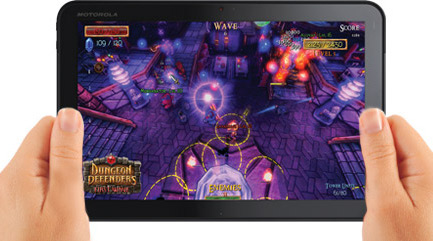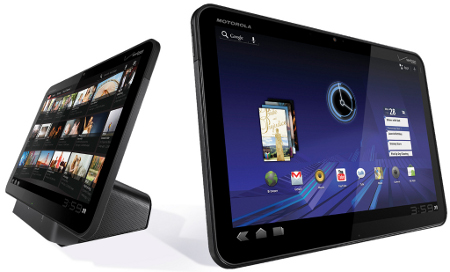Review: Motorola Xoom tablet excels at multitasking
Mar 3, 2011 — by LinuxDevices Staff — from the LinuxDevices Archive — viewsEven in the reflected light of the impressive new dual-core, dual-camera iPad 2, the Android 3.0-driven Motorola Xoom tablet holds its own, says this eWEEK review. Although the price is steep and optimized apps are hard to come by, the Xoom's zippy multitasking, a slick Honeycomb interface, well-crafted cameras, long battery life, and an impending 4G upgrade help make the tablet a winner.
Normally it would be hard to compose a review of a tablet computer on the same day Apple's iPad 2 is unveiled, but Motorola's Xoom, the first slate based on Google's Android 3.0 "Honeycomb" operating system, makes it easy. I imagine a lot of blood, sweat, and tears went into making this tablet with a 10.1-inch HD screen with 1280-by-800 pixel resolution because I'm getting a lot of joy out of using this loaner unit from Verizon Wireless.

Motorola Xoom
Sure, you can go off contract, but that's still $70 more than what you'd pay for a comparable iPad. Where was the value prop?
For me, it's in the Xoom's multitasking, which is better than on the original iPad. (A verdict on the iPad2 will await its Mar. 11 ship date.) The Xoom presentation just looks and feels better than the iPad, which I've spent a fair amount of time with.
The Xoom is clearly faster than the first generations of the iPad or Samsung Galaxy Tab because it is powered by Nvidia's Tegra 2 dual-core 1GHz processor. That proved true whether I was connected via Wi-Fi at home or via Verizon's 3G network on a train to New York.
The 3D graphics, courtesy of Honeycomb's Renderscript engine, make the Xoom pop. Some folks reading this have no doubt heard about the 3D capabilities of Google Maps 5.0 on Honeycomb. Buildings on Google Maps raise as users zoom in and tilt. Very cool.
The Xoom is also preloaded with games such as Cordy and Dungeon Defenders, which look and play fantastic. And you can't go wrong with the trusty Angry Birds time waster.
Indeed, the Xoom leverages Google's fresh approach in Android 3.0, which includes lively widgets that users can drag and drop with their fingers to any one of five customizable homescreens. "Grid widgets" appear stacked in little quadrants, and a simple tap whisks users straight to Facebook, Twitter, Wikipedia and other websites. Users may also scroll through the Google Calendar widget.

Xoom, on the stand (left) and off
Google's eBooks app is preloaded with access to three million free books, as is a music app with preselected songs from a variety of artists. The dual speakers on the Xoom make music clear and clean to the ear. Users may also copy music from their computers to the Xoom.
Searching Google via text input and via Google Voice Search from the search bar on each homescreen proved snappy. Voice Search is particularly good because you don't have to practically put the Xoom in your mouth the way you do an Android handset to help the microphone pick up your words.
Productivity on the Xoom is decent. Gmail has been refreshed to be more PC-like, with folders along the left-hand rail, and inbox messages on the right, making it much more user friendly than using the app on a smartphone.
Users may also sync their Microsoft Exchange corporate e-mail, contacts, and calendars, and work on documents, spreadsheets and presentations from the virtual QWERTY keyboard.
I typed the review in an application I downloaded from the market called Gdocs. It takes some getting used to, sort of like texting did on my Motorola Droid X's touchscreen, but these keys are nice and wide, obviously more generously spaced than they are on the smartphone. If pressed, though, I'd still rather type on the iPad's virtual keyboard.
Cool cameras
The cameras are excellent. While I've appreciated the eight-megapixel capability of my Droid X, I'll take this five-megapixel shutter on the Xoom over it easily. Sure, it's awkward to hold up a 1.6 pound tablet to take a picture, but it's actually easier than on a smartphone because the view finder is wider. Also, there was no shakiness or latency when I pressed the camera button to snap a photo.
 Switching from the camera to the video recorder is easier than with the Droid X. The camera captures video in 720p, and you can then port the videos or images to an HDTV with an HDMI cable, or pipe them to Facebook, Twitter, YouTube, or Flickr.
Switching from the camera to the video recorder is easier than with the Droid X. The camera captures video in 720p, and you can then port the videos or images to an HDTV with an HDMI cable, or pipe them to Facebook, Twitter, YouTube, or Flickr.
I tried the video chat capability using Google Chat, which is cool because you get notifications when a friend comes online. When you see their profile picture pop out below, it's hard not to resist pinging them for a video chat.
The Xoom measures 9.8 inches long, 6.6 inches wide and only half an inch thick. Despite the 10.1-inch size, battery life on the Xoom is great. I used it for several hours over the course of a day and got about nine to 10 hours before it wound down. I'd kill for that on my Motorola Droid X, or any of the other Android handsets I've tested. The Motorola Atrix 4G comes close.
Criticisms: app gap, tiny buttons, and a smudgy screen
One obvious problem with the Xoom is the lack of apps tailored for Honeycomb. Sure, you can choose any of the 130,000-plus Android Market apps, but most won't fit on the Xoom properly because they weren't optimized for tablets.
Apple CEO Steve Jobs said there were 100 Honeycomb-tailored apps compared to 65,000 for the first iPad. I'm certain I'll never need 100 apps ever on a device at one time, let alone 65,000, but choice matters to people.
One annoying hardware detail is the tiny, almost non-existent volume buttons on the left side of the Xoom. Slightly less annoying was the mini power button on back. These are not ideal for clumsy fingers like mine.
Also, wiping the screen clean is a constant chore. Unfortunately, I prefer darker wallpapers, so when I switched from a bright Android background to a darker one, I saw my smudges. We need a screen technology where finger oils evaporate on contact. My guess is Apple will nail that one first.
Final thoughts
Should you buy a Xoom? Depends. Do you prefer Android products and loads of integrated Google apps, such as Google Talk, YouTube, Gmail, Google Maps, Google Places and Google Latitude? These apps, along with games, are rendered deliciously on the Honeycombed Xoom. If so, a Xoom is right for you.
We now know the iPad 2 is cheaper, priced from $500 to $830, depending on what version you get, making it more cost effective than the Xoom. But part of the justification for the Xoom's higher cost, as recently revealed by Motorola Mobility CEO Sanjay Jha , is that it's 4G-upgradeable for free on Verizon's 4G LTE network later.
Earlier this week, IHS iSuppli published a teardown report stating that the Xoom costs about $359 in materials, or a little bit more than the midlevel iPad 1.
It's important to note the iPad 2 sports a new A5 dual-core processor, but we won't know which tablet is faster until review units arrive. Even if the iPad 2's processor turns out to be faster than the Xoom's Tegra 2, Apple's tablet still doesn't offer 4G bandwidth, which should have an major impact on the performance of web interactions.
In short, folks who prefer Android to Apple iOS will likely grab a Xoom. You can't go wrong with the Xoom if you're looking for speedy web surfing and multitasking. You just have to be willing to spend a little more… or wait.
That's right, with the iPad 2 priced the same as the first iPads, I predict we'll soon see a Xoom price drop to $500 with contract, maybe $700 without, just as we saw all four major U.S. carriers slash the price of the Galaxy Tab when it failed to sell.
You may also wait to see the pricing and performance of the Samsung Galaxy Tab 10.1, LG G-Slate, and similar LG Optimus Pad, the upcoming Toshiba tablet, or other 10.1-inch, Tegra 2-powered Honeycomb tablets later this year. In the meantime, the Xoom will serve you well.
eWEEK coverage of the iPad 2 includes:
- Apple iPad 2 includes speedy A5 processor, thin body, cameras
- Apple iPad 2 introduction: 10 features that define this new model
- Apple iPad 2: not what we hoped for, but not too shabby, either
- Apple iPad 2 a strong second act, but no competition killer: analysts
Clint Boulton is a writer for our sister publication eWEEK.
This article was originally published on LinuxDevices.com and has been donated to the open source community by QuinStreet Inc. Please visit LinuxToday.com for up-to-date news and articles about Linux and open source.